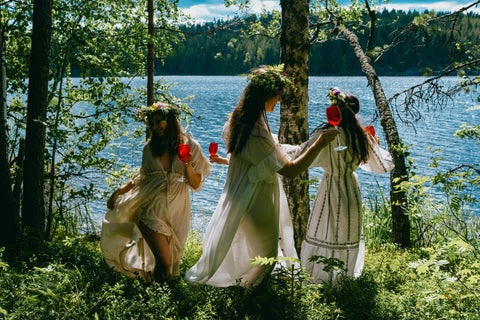The Magic of Midsummer: Summer Solstice Rituals & Folklore Around the World
Across cultures, the longest days of the year have always been a time of magic, celebration, and storytelling. The peak of summer, marked by the solstice, was never just about warmth; it was a powerful moment of connection to nature, myth, and community. From roaring fire festivals that ward off spirits to joyous dances that welcome abundance, these ancient traditions still echo today.
At , we’re fascinated by how these customs ripple through modern life, often inspiring the prints, zines, and candles we create. Join us as we explore the folklore that lights up the height of summer.

Midsummer Bonfires: Celtic & Scandinavian Fire Festivals
In Sweden, Finland, and across the British Isles, Midsummer's Eve is famously marked by enormous bonfires. Historically, the flames were believed to be a source of purification and protection, cleansing the land and warding off misfortune for the year ahead. In a display of courage and hope, young people would often leap through the embers for luck in love and fertility.
This tradition is closely linked to the ancient Celtic and pagan festival of Litha, which honours the immense power of the sun at its peak. Folklore also tells us that herbs gathered on this night, like St. John's Wort, were imbued with extraordinary healing and protective properties.
Kupala Night: A Slavic Midsummer Celebration
Slavic cultures celebrate Ivana Kupala Night around the summer solstice. It's a night steeped in romantic and mystical traditions. Young women craft flower garlands and float them on rivers, their path believed to foretell their romantic future. Elsewhere, couples test their bond by leaping hand-in-hand over a bonfire; if they don't let go, their connection is said to be strong.
One of the most captivating legends is that of the fern flower, said to bloom for a single, fleeting moment at midnight. The person fortunate enough to find this mythical blossom is granted a lifetime of wisdom and fortune.
What does Ivana Kupala mean?
Rooted in pagan sun worship, "Kupala" symbolises the birth of the summer sun, Kupalo. The festival merges these ancient solar traditions with later Christian influences (St. John the Baptist, or "Ivan"), creating a unique cultural blend of fire, water, and celebration.

Obon Festival: Guiding Ancestral Spirits in Japan
While typically celebrated in mid-August, Japan's Obon Festival shares the summer's deep sense of spiritual connection. During this time, families light beautiful lanterns (chōchin) to guide the spirits of their ancestors back to their homes for a temporary return.
The warm, dark evenings are often filled with ghost stories (kaidan), told by lantern light, serving as a reminder of the thin veil between the world of the living and the spirit realm. Far from being a sombre occasion, communities come together for the Bon Odori, a joyful dance that turns remembrance into a vibrant celebration of life and heritage.
Why are lanterns important in Obon?
The lanterns of Obon serve a dual purpose. Primarily, their light acts as a beacon to guide ancestral spirits home and then back to the spirit world. They also serve as a beautiful, glowing symbol of remembrance and the enduring light of family connection.
Adonia: Love and Loss in Ancient Greece
In Ancient Greece, women observed the festival of Adonia to mourn the tragic death of Adonis, the mortal lover of the goddess Aphrodite. They would plant "gardens of Adonis" in small pots—fast-growing herbs like lettuce and fennel that sprouted quickly in the heat but also withered just as fast under the intense summer sun.
This fleeting, ephemeral growth was a powerful metaphor for the fragility of life, the intensity of passion, and the inevitable cycles of love, death, and renewal.
First Fruits Festivals in Southern Africa
Across Southern Africa, the early summer harvest was traditionally marked with First Fruits ceremonies. These were vibrant community events filled with drumming, dance, and storytelling, expressing deep gratitude to the land and the ancestors for their bounty.
Folklore connected these festivals to the sacred duty of living in harmony with nature. They reinforced the importance of respecting the earth and honouring the endless cycles of growth, harvest, and regeneration.
Why Summer Folklore Still Speaks to Us
What unites these diverse traditions is a shared sense of wonder at the peak of the sun's power. Midsummer has always been a liminal time—a threshold where light, life, and mystery converge. Whether it’s fire chasing away shadows, flowers predicting the future, or lanterns guiding spirits, summer is a season that has always inspired us to believe in magic and tell stories.
Bring Folklore into Your Home
If these tales have stirred your imagination, you can invite the spirit of summer folklore into your own space with pieces from our collection:
-
Folklore Art Prints – Our British Isles Folklore Creatures Print keeps mythical beings alive on your walls.
-
Zines – Weird Walk is perfect for wandering through seasonal rituals and hidden histories.
-
Candles – Light one during your own rituals or quiet evenings to echo the glow of midsummer bonfires.

